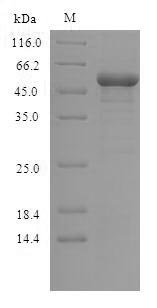Recombinant Human Glycogen synthase kinase-3 beta (GSK3B) comes from a yeast expression system and contains the complete 1-420 amino acid sequence. The protein includes an N-terminal 6xHis tag that helps with purification and detection processes. SDS-PAGE analysis shows the product reaches over 90% purity, which appears suitable for research applications that need high-quality protein. This product is intended for research use only and keeps endotoxin levels low.
Glycogen synthase kinase-3 beta (GSK3B) functions as a serine/threonine kinase that participates in multiple cellular processes. These include glycogen metabolism regulation, cell signaling, and transcription control. The protein plays an important role in the Wnt signaling pathway and acts as a key regulator for several transcription factors and other proteins. GSK3B's participation in these pathways suggests its significance in cellular function and makes it relevant for research examining metabolic and signaling networks.
Potential Applications
Note: The applications listed below are based on what we know about this protein's biological functions, published research, and experience from experts in the field. However, we haven't fully tested all of these applications ourselves yet. We'd recommend running some preliminary tests first to make sure they work for your specific research goals.
Based on the provided information, the recombinant Human GSK3B is expressed in a Yeast expression system, which is capable of producing folded eukaryotic proteins but may not replicate all post-translational modifications found in mammalian systems (e.g., phosphorylation patterns critical for kinase regulation). The protein is full-length (1-420aa) with an N-terminal 6xHis tag, and purity is >90% by SDS-PAGE, indicating low contamination. However, since activity is unverified, the protein cannot be assumed to be correctly folded or bioactive without functional validation (e.g., kinase activity assays). GSK3B requires precise folding for its kinase function and interactions, so while the yeast system offers a better chance for correct folding compared to prokaryotic systems, confirmation is essential.
1. Protein-Protein Interaction Studies Using His-Tag Pull-Down Assays
The N-terminal 6xHis-tag allows for immobilization in pull-down assays, but if GSK3B is misfolded, it may not interact physiologically with binding partners, leading to non-specific or false interactions. The high purity reduces background, but results should be interpreted cautiously until folding is validated. If correctly folded, this application is feasible; otherwise, it risks artifacts. It should emphasize the need for activity confirmation before biological interpretations.
2. Antibody Development and Validation
This recombinant GSK3B can serve as an immunogen for antibody generation, as antibodies may recognize linear epitopes even if the protein is misfolded. However, yeast PTMs (e.g., hypermannosylation) differ from mammalian ones, which could affect antibody specificity. Antibodies should be validated against native GSK3B from human cells to ensure recognition of conformational epitopes.
3. Biochemical Characterization and Protein Stability Studies
This application is appropriate and low-risk, as it directly assesses folding and stability. Techniques like circular dichroism or thermal shift assays can evaluate protein conformation without requiring bioactivity. The high purity supports reliable data. Even if misfolded, these studies provide valuable insights into the recombinant product's properties.
4. Small Molecule Screening and Binding Studies
This application is highly dependent on correct folding. If GSK3B is misfolded, small molecule binding data (e.g., from SPR or thermal shift assays) may be invalid, leading to false hits or misleading kinetics. The His-tag facilitates immobilization, but activity must be verified first (e.g., with kinase assays). The screening should only proceed after confirming bioactivity.
Final Recommendation & Action Plan
Given the uncertainty in folding and bioactivity, prioritize validating the protein's conformation and function through biophysical assays (e.g., circular dichroism for secondary structure, size-exclusion chromatography for oligomeric state) and functional kinase activity tests before proceeding with interaction or screening studies. If validated, the protein can be used for all described applications; if not, focus on biochemical characterization and antibody development (with appropriate validation against native protein). For small molecule screening, always include positive controls (e.g., known GSK3B inhibitors) to ensure reliability. Given the yeast expression, be aware of potential PTM differences that might affect applications requiring mammalian-like modifications.






